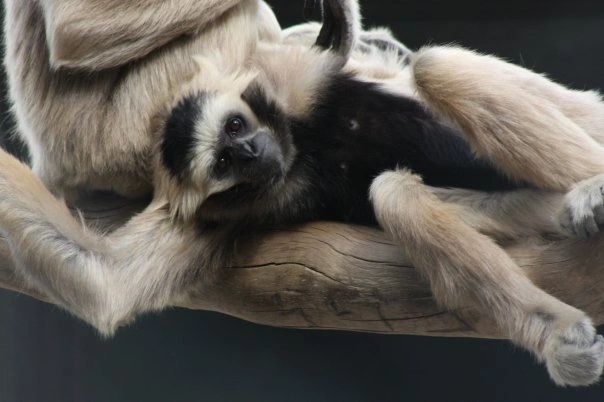THE PLIGHT OF THE GIBBON APES
.
THE PLIGHT OF GIBBON APES
Article and Images by Christina Bush
Scientific (genus) name: Hylobatidae
Gibbons apes are rare, small, very slender, long-armed tree dwelling apes native to most of Southeast Asia. They inhabit
the tropical and sub-tropical rain forests in the countries of China, Burma, N. Sumatra, Cambodia, Borneo, Java and Vietnam. These small apes have hairless faces, dark eyes, small nostrils and jet black skin. They have fluffy, dense fur with color variations from very dark to light brown shades and anywhere in between black and white. The color of infants of some species are different from the adults. Although rare, there are a few completely white gibbons.
There are two main groups of apes, the Great Apes and the Lesser Apes. The great apes include gorillas, chimpanzees, orangutans, and bonobos. Gibbons make up the “lesser apes” group, the largest group of all the apes. According to the Gibbon Conservation Center in Santa Clarita, California, there are 15 living gibbon species, which are categorized into 4 genera: Nomascus, Symphalangus, Hoolock and Hylobates. There is only one sub-species of gibbons, which are called the Siamangs and are the largest of all the gibbons apes. The Hainan gibbon (Nomascus Hainanus), found only on the Hainan Island and off the coast of China, is considered to be the world's most endangered primate. There are only approximately 20 individuals left on the island. Also nearly extinct is the Hainan gibbon's closest relative, the Cao Vit gibbon from the Pu Mat National Park in Vietnam, which has about 100 individuals remaining.
Unlike the Great Apes, gibbons are monogamous and mate for life. Less than 6% of all primate species (of more than 300) are considered monogamous. They reproduce at around 12-13 years old and after a seven month gestation period usually give birth to a single hairless baby. Twins births sometimes occur but are rare. Adults weigh between 20-30 pounds and stand around three feet tall when upright. The largest species of Siamangs can weigh up to 40 pounds and be a bit taller than the other species. Gibbons live in small, stable family groups consisting of a mating pair and their immature offspring of juveniles under seven years old. The life expectancy for gibbons is around 35-40 years. In the wild, a gibbon family has a territory of about 30-50 acres in the old-growth areas of the rain forest. These very social animals are small and light-weight with arms longer than their legs and they have no tail, a feature distinguishing apes from monkeys. They have four times the strength of a human being and can recognize themselves in a mirror, a very unique trait.
Females are the dominant animal in the family group. They nurture their young and wean them at around one year of age. The young gibbons eventually venture out from their mothers at around age six or seven. In most species, males and females are the same size but are often sharply distinct in their coloration. Unique to the family, the basal part of the thumb is freed from the palm, allowing for superior locomotion through the trees. Gibbons do not build nests like the great apes. They sleep sitting up with their arms wrapped around their knees and their head tucked into their lap. These apes are omnivores that forage through the forest during the day eating lots of fruit, leaves, flowers, seeds, tender plants, and tree bark. They also enjoy eating insects, birds, bird eggs, spiders and have a particular craving for figs in the wild. They are most active during the day, especially in the early morning hours.
They are the fastest and most agile of all tree-dwelling, non-flying animals and are known for being acrobatic masters. They are arboreal and live in well-defined territories high in the treetops. They love to swing all over the jungle 200 feet up in the branches above and can swing for distances of up to 50 feet at speeds as high as 35 miles per hour, moving swift as a bird with fluid grace. Because they are so agile while moving in the trees, almost no predators can catch them. When on the ground, they walk on two legs. They cannot swim and completely avoid the water. Gibbons are very strongly territorial displaying piercingly loud whooping and hooting calls each morning, resonating their vocal chords with beautiful song. Often they are referred to as the “songbirds” of the primate family and the most musical of all the land mammals. Their loud vocalization can be heard for up to a mile away and is used to announce location, defend territory and maintain bonds within the family unit. The adult pair, sometimes joined by practicing juveniles, sing duets. Each individual gibbon can be identified by his or her song. Duets are usually sung for less than half an hour each day, but males may call on their own for two hours or more. Siamang gibbons, the largest and darkest species of gibbons, have a louder call and can be heard up to two miles away.
The plight of the small apes receives virtually no media coverage and several species have never been studied in the wild, filmed or bred in captivity. Many consider gibbons to be the “Forgotten Apes”. Gibbons face a wide range of threats to their demise, including habitat loss, poaching, the exotic pet trade, and use of their body parts in the manufacture of traditional medicines. Gibbon conservation attracts less funding than that of the great apes and, unfortunately, their natural habitat is being destroyed at the alarming rate of 32 acres per minute. As human populations continue to increase in Southeast Asia, along with the accelerating habitat destruction from logging and agriculture, there has been a devastating effect on every species of gibbon. Each of the species of is threatened with extinction and some of them direly so. A recent survey by Conservation International about one of the rarest subspecies, the Yunnan white-handed gibbon, concluded that the populations in southernmost China have been completely extirpated, and it is unknown whether they still survive anywhere else.
If gibbons are to survive the next few years, the highest priority must be given to establishing and enforcing protected areas in suitable habitats for their remaining populations. Breeding centers and broad-based campaigns of conservation education, as well as stricter and better-enforced management of their land and the exotic pet trade will be needed to prevent the extinction of these exceptional primates.
Expressions of India Magazine, September 2011 Issue








































